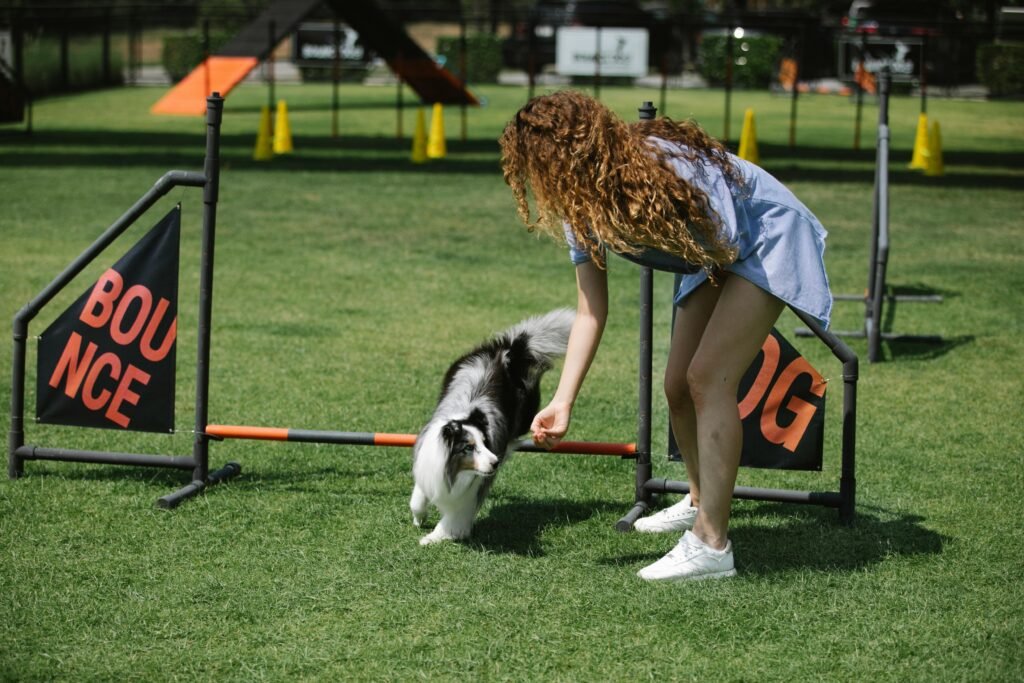In 2024, dog meditation is gaining popularity as a wellness trend for pets. This practice aims to provide benefits to dogs similar to those experienced by humans. This guide covers everything you need to know about dog meditation, from its benefits to how to practice it and expert opinions on its effectiveness. 2024’s Top Pet Wellness Trend What Is Dog Meditation and Does It Work.
In 2024, the pet wellness industry has witnessed a significant shift towards holistic and integrative approaches to animal care, with dog meditation emerging as a top trend. This novel concept is rooted in the belief that dogs, like humans, can benefit from mindfulness practices to improve their overall well-being.
Understanding Dog Meditation
What Is Dog Meditation?
Dog meditation is a practice involving calming exercises like breathing techniques and guided imagery in relaxing environments to help dogs reduce stress and anxiety and promote mental well-being, similar to human meditation.

Why Dog Meditation?
Dogs, like humans, can feel stress and anxiety from factors like environmental changes and loud noises. Dog meditation is a natural way to help manage these issues, improving their quality of life.
Benefits of Dog Meditation
1. Reduces Stress and Anxiety
Dog meditation reduces cortisol levels, alleviating stress for a calmer pet. Regular sessions help dogs manage anxiety from thunderstorms, fireworks, or separation.
2. Improves Behavior
Calm dogs display good behavior. Meditation reduces hyperactivity and aggression, making dogs easier to manage. Especially helpful for dogs with behavioral issues.
3. Enhances Bonding
Meditating with your dog can strengthen the bond between you and your pet. The shared experience of relaxation and focus can enhance trust and communication, leading to a deeper and more meaningful relationship.
4. Promotes Overall Well-being
Regular meditation can contribute to a dog’s overall well-being by improving their mental health. A balanced and stress-free mind can positively impact physical health, leading to a happier and healthier pet.
How to Practice Dog Meditation
Preparing for Meditation
Prepare a quiet, comfortable space for a calming dog meditation session. Consider using a calming mat or blanket to help your dog relax.
Steps to Meditate with Your Dog:
Start with Breathing: Begin by focusing on your breathing. Take slow, deep breaths and encourage your dog to do the same by mimicking your calm demeanor.
Guided Imagery: Use guided imagery to help your dog relax. Imagine a peaceful place like a quiet beach or a serene forest. Speak softly and calmly, describing the scene to your dog.
Physical Contact: Gentle petting or massaging can help your dog relax. Focus on areas where your dog enjoys being touched, such as behind the ears or along the back.
Mindfulness: Encourage mindfulness by paying attention to your dog’s body language and breathing. Stay present in the moment, enjoying the shared experience of relaxation.
Consistency: Regular practice is key to seeing benefits. Aim for short, consistent sessions rather than occasional long ones.
Tools and Resources
Calming Music: There are numerous playlists and albums specifically designed to calm dogs. Try different ones to see what works best for your pet.
Aromatherapy: Certain scents, like lavender and chamomile, can have a calming effect on dogs. Use essential oils safely, ensuring they are diluted and pet-friendly.
Guided Meditation Apps: Some apps offer guided meditation specifically for pets. These can be a helpful tool for beginners.

Expert Opinions on Dog Meditation
Veterinarian Insights
Many veterinarians acknowledge the potential benefits of dog meditation, especially for reducing anxiety and improving behavior. Dr. Sarah Jones, a veterinarian with over 20 years of experience, notes, “While the concept of dog meditation is relatively new, we’ve seen promising results in dogs with anxiety and stress-related behaviors. It’s a great complementary practice alongside traditional training and veterinary care.”
Animal Behaviorists
Animal behaviorists also see value in meditation practices for dogs. According to John Smith, a certified animal behaviorist, “Dog meditation can be an effective way to manage stress and anxiety. It helps dogs learn to relax and focus, which can translate to better behavior and a more harmonious household.”
Skeptical Views
Despite the enthusiasm, some experts remain skeptical about dog meditation’s effectiveness. Dr. Emily Brown, a veterinary psychologist, points out, “While meditation may help some dogs, it’s not a one-size-fits-all solution. Owners should be cautious and combine meditation with other proven methods like behavioral training and environmental enrichment.”
Case Studies and Success Stories
Case Study 1: Bella the Rescue Dog
Bella, a rescue dog with severe anxiety, struggled in her new home until Jane tried dog meditation. Jane practiced daily sessions with Bella, gradually reducing her anxiety. Thanks to dog meditation, Bella adjusted and thrived.
Case Study 2: Max the Hyperactive Puppy
Max, a hyperactive Labrador puppy, had difficulty calming down and focusing. His owner, Tom, introduced dog meditation as part of Max’s daily routine. By incorporating meditation sessions, Max learned to relax and became less hyperactive. Tom found that Max’s behavior improved significantly, making training easier and more effective.
Case Study 3: Daisy and Her Thunderstorm Phobia
Lisa helped Daisy cope with her thunderstorm phobia by practicing dog meditation techniques. Through consistent practice, Daisy’s anxiety decreased, making her more resilient. Lisa found this tool valuable.
Potential Challenges and Solutions
Challenge 1: Initial Resistance
Some dogs may be resistant to meditation at first. They might be restless or uninterested in the practice. It’s essential to be patient and persistent, gradually introducing meditation in short, manageable sessions.
Solution: Start with brief sessions and slowly increase the duration as your dog becomes more comfortable. Use treats and positive reinforcement to encourage participation.
Challenge 2: Distractions
Maintaining a calm environment can be challenging, especially in busy households. Distractions can disrupt the meditation session and make it difficult for your dog to relax.
Solution: Choose a quiet time and place for meditation. Consider using a dedicated space that your dog associates with relaxation. Inform family members to minimize interruptions during meditation sessions
Challenge 3: Inconsistent Practice
Consistency is crucial for seeing the benefits of dog meditation. Irregular practice may not yield the desired results and can be confusing for your dog.
Solution: Establish a routine and set aside a specific time each day for meditation. Consistent practice helps reinforce the behavior and makes it a regular part of your dog’s routine.
Integrating Dog Meditation with Other Wellness Practices
Nutrition and Diet
Proper nutrition plays a vital role in your dog’s overall well-being. A balanced diet supports mental and physical health, making your dog more receptive to meditation practices.
High-Quality Food: Choose high-quality, natural pet foods that provide essential nutrients.
Supplements: Consider supplements like omega-3 fatty acids, which can support brain health and reduce inflammation.
Physical Exercise
Regular physical exercise is essential for a dog’s health. Exercise helps release pent-up energy and reduces stress, making it easier for your dog to relax during meditation.
Daily Walks: Ensure your dog gets regular walks and playtime.
Interactive Toys: Use toys that stimulate your dog’s mind and body.

Veterinary Care
Regular veterinary check-ups are crucial for maintaining your dog’s health. Addressing any medical issues promptly can prevent stress and anxiety.
Routine Check-Ups: Schedule regular visits to the veterinarian to monitor your dog’s health.
Behavioral Consultation: If your dog has severe anxiety or behavioral issues, consider consulting a veterinary behaviorist.
Future of Dog Meditation
Research and Studies
The field of dog meditation is still in its infancy, and more research is needed to understand its full potential and limitations. Ongoing studies aim to explore the physiological and psychological effects of meditation on dogs.
Technological Advancements
Advancements in technology could enhance the practice of dog meditation. Wearable devices that monitor a dog’s heart rate and stress levels could provide insights into the effectiveness of meditation practices.
Increasing Popularity
As more pet owners become aware of the benefits of dog meditation, its popularity is likely to grow. Online communities and resources can provide support and guidance for those interested in incorporating meditation into their dog’s routine.
Conclusion
Dog meditation is a new trend in pet wellness for 2024, offering a natural way to enhance mental and physical well-being. Understanding and incorporating dog meditation into a wellness routine can help pets lead happier lives. It can be beneficial for anxious, hyperactive, or phobic dogs, with patience and consistency being important. This practice emphasizes mental wellness and is becoming more popular in pet care. Research and success stories show its potential as a staple in pet wellness practices. Giving it a try could lead to tranquility and improved well-being for your dog through a peaceful moment of meditation.

